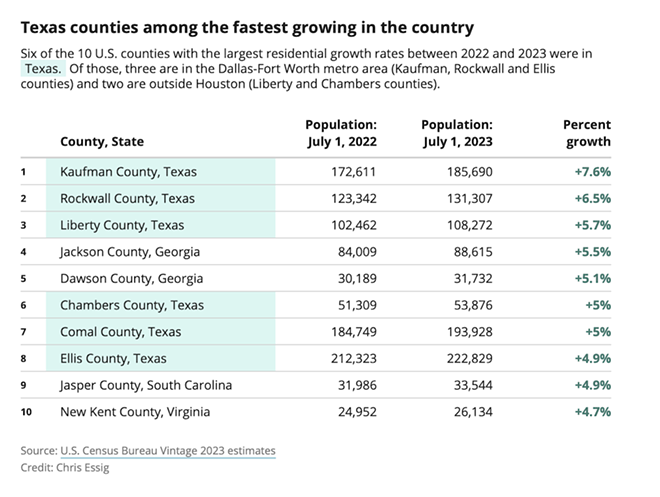
Six out of the 10 fastest-growing counties in the U.S. from 2022 to 2023 are in Texas, according to recent estimates from the U.S. Census Bureau.
Kaufman County, just east of Dallas, led the list with a 7.6% increase that brought its population over 185,000, Census data shows. Rockwall and Liberty counties followed closely behind, each with growth bursts of 6.5% and 5.7%, respectively.
Population increases across the southern U.S. were largely due to people relocating from other parts of the country, Census officials said. On average, counties in the South experienced faster growth in 2023 than in 2022.
“Domestic migration patterns are changing, and the impact on counties is especially evident,” said Lauren Bowers, chief of the Census Bureau’s Population Estimates Branch, in a Thursday statement.
Big counties see major population increases
Texas also holds eight out of the ten counties across the country that added the most residents from 2022 to 2023. Harris, Collin and Montgomery counties led the pack.
Harris County added 53,788 residents, more than any other county in the U.S. With nearly 5 million total residents, it’s now the third most populous county in the country. Harris also saw the second-highest gains from international migration of all counties nationwide.
Collin, Denton and Tarrant counties in the Dallas-Fort Worth area also had significant gains, bringing in tens of thousands of new people. Denton is now the seventh county in Texas to surpass 1 million residents.
Notably, Dallas County didn’t make the Census’ top ten list.
Growth in the state’s major counties boosted Texas’ overall population. The state grew more than any other in the country in 2023, by nearly half a million people, according to earlier Census estimates.
Texas cities are booming
Texas’ four most populous metro areas — Dallas-Fort Worth, Houston, San Antonio and Austin — were among the top 10 metro areas with the biggest population increases from 2022 to 2023.
The greater Dallas area saw the highest jump. It added 152,598 residents, bringing its total population over 8 million. The greater Houston area followed closely behind, adding 139,789 over the same period. Its total population is now over 7.5 million residents.
Nearly 70% of Texas residents live in the state’s four largest metro areas, according to estimates from the Texas Demographic Center.
But the Midland metro area grew more rapidly than any of them. From 2022 to 2023, Midland’s population increased by nearly 3% — making it the seventh fastest-growing metro area in the country.
Midland is part of the Permian Basin, the highest-producing oil field in the U.S., and is home to much of Texas’ oil and gas production.
Tracee Bentley, CEO of Permian Strategic Partnership — a collaboration between Permian Basin communities and oil and gas companies — said job growth in the energy sector could be driving population increases in Midland.
“The nature of the jobs that you’re seeing in the oil and gas space are attracting some of the younger professionals who want to come here,” Bentley said.
Overall, more U.S. counties saw population gains than losses in 2023, but the South saw faster growth than much of the rest of the country, according to Census data.
This article originally appeared in the Texas Tribune.
The Texas Tribune is a member-supported, nonpartisan newsroom informing and engaging Texans on state politics and policy. Learn more at texastribune.org.
Subscribe to SA Current newsletters.Follow us: Apple News | Google News | NewsBreak | Reddit | Instagram | Facebook | Twitter| Or sign up for our RSS Feed



















